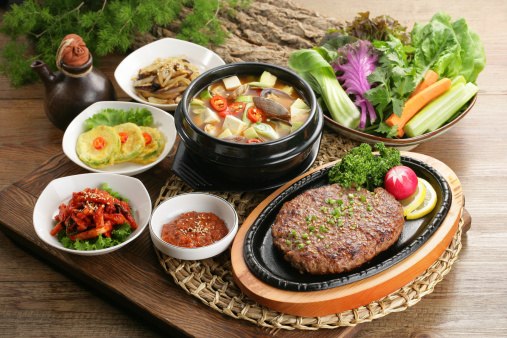Korean food is pretty hot of late (both figuratively and literally). With fusion dishes of the Korean variety floating around, along with Korean food trucks, Korean barbeque and of course the increased awareness of kimchi’s “super food” status, cuisine originating from the Korean Peninsula is really coming into its own in the West.
If Korean fare and spicy offerings haven’t shown up on your radar yet, you’re really missing out. As I’ve just stated, kimchi (spicy fermented cabbage and other vegetables) is a side dish endowed with seemingly unbelievable powers. It’s so healthy, in fact, that many news outlets have named it as one of the healthiest foods on the planet. It’s chock-full of vitamins and healthy bacteria that aid in digestion. True, if you eat a ton of kimchi your sweat will smell like chilies and garlic — but since it might also help in combating cancer growth, that “kimchi smell” could be the key to your future longevity.
Korean barbeque is another great way into Korean cuisine. If you haven’t dug into some Korean meat dishes with names like bulgogi (grilled beef) or dak galbi (chicken marinated in chili pepper paste), then you really should — provided that you have a bit of a carnivorous streak in you. (These dishes are not for vegetarians.)
Besides kimchi and various “galbi” (meat) dishes, you can also come across a plethora of tasty food items that are singular to the Korean style of cooking. Korean food is actually very distinct from the regional dishes of some of its neighbors, like China and Japan. Here’s a brief sampling of some of my favorites Korean dishes and snacks:
- Bibimbap – This one is a classic. It’s a rice dish with mixed vegetables, thinly sliced beef, and an egg. The seasoned and marinated veggies really make the bibimbap stand out. You get lots of goodies like bean sprouts, carrots and mushrooms. Of course, don’t forget a spoonful or two of gochujang (red pepper paste) on top. Once you have all of the ingredients ready, mix them together in a bowl. If you’d like to add a little extra flair, why not go in for a “dolsot” bibimbap, which is served in a hot stone bowl. Lots of variations on the traditional bibimbap exist for you to experiment with.
- Ddeokbokki — I love this dish, even though in Korea it’s considered a kid’s food — kind of like how we look at a box of Kraft Macaroni & Cheese. Ddeokbokki is a plate made up of rice cakes, fish cakes and a ton of sweetened chili sauce (gochujang). Sometimes cooked egg slices and noodles are thrown into the mix as well. This is belly-warming comfort food, Korean style.
- Japchae — A great potato noodle dishes — especially when it’s loaded with chilies — made with beef, onion, thinly sliced carrots, steamed spinach and a fair amount of sesame oil and soy sauce.
- Kimbap – These little guys were California sushi rolls before California sushi rolls became a thing. A variety of meats and vegetables are wrapped up in seaweed and then sprinkled with sesame seeds and sesame oil. You get kimbap made with chilies, cheese, ham, kimchi, beef and lots of other delectable ingredients. Kimbap makes for a great snack when you’re busy and on the go.
- Kimchi bokkeumbap – Fried rice with a lot of kimchi and pork, as well as a few vegetables. This is a hearty meal (served hot) that can feed and satisfy everyone at the lunch or dinner table.
- Naengmyeon – Cold buckwheat noodles in a cold broth served with some beef, eggs and vegetables (also cold). This dish is a great way to load up on your vegetable allowance for the day all in one go.
- Ojingeo deopbap – Squid or calamari rings stir-fried and served with rice. And yes, as you might have guessed by now, plenty of gochujang (hot red chili paste) is added to spice things up.
These are just a few of the many dishes you can have in Korea, or at your local Korean restaurant — if you’re lucky enough to have one in your neighborhood. In addition to the main courses, Korean meals are served with plenty of wonderful little side dishes known as “banchan.” These small plates range from normal kimchi (like you had to ask), bean sprouts in sesame oil and cucumber kimchi to shredded squid, marinated tofu and more. Half the fun of going out for a Korean meal is snacking on all of the banchan.
Regardless of how you’re introduced to Korean food — be it through kimchi, marinated beef or tiny vegetables dishes — it’s definitely an international cuisine you should try. If you can handle a bit of spice on occasion, Korean food is a wonderful way to liven up your everyday eating habits.














-300x200.jpeg)
-300x213.jpeg)










